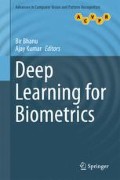Abstract
Gender classification from NIR iris image is a new topic with only a few papers published. All previous work on gender-from-iris tried to find the best feature extraction techniques to represent the information of the iris texture for gender classification using normalized, encoded or periocular images. However this is a new topic in deep-learning application with soft biometric. In this chapter, we show that learning gender-iris representations through the use of deep neural networks may increase the performance obtained on these tasks. To this end, we propose the application of deep-learning methods to separate the gender-from-iris images even when the amount of learning data is limited, using an unsupervised stage with Restricted Boltzmann Machine (RBM) and a supervised stage using a Convolutional Neural Network (CNN).
References
L.A. Alexandre, Gender recognition: a multiscale decision fusion approach. Pattern Recognit. Lett. 31(11), 1422–1427 (2010)
A. Bansal, R. Agarwal, R.K. Sharma, SVM based gender classification using iris images, in Fourth International Conference on Computational Intelligence and Communication Networks (CICN, 2012), pp. 425–429
Y. Bengio, P. Lamblin, D. Popovici, H. Larochelle, Greedy layer-wise training of deep networks (2007), pp. 153–160
D. Bobeldyk, A. Ross, Iris or periocular? Exploring sex prediction from near infrared ocular images, in Lectures Notes in Informatics (LNI), Gesellschaft fur Informatik, Bonn (2016)
K.W. Bowyer, K. Hollingsworth, P.J. Flynn, Image understanding for iris biometrics: a survey. Comput. Vis. Image Underst. 110(2), 281–307 (2008)
CANPASS, Canadian border services agency, CANPASS (1996)
M.A. Carreira-Perpinan, G.E. Hinton, On contrastive divergence learning (2005)
M.D. Costa-Abreu, M. Fairhurst, M. Erbilek, Exploring gender prediction from iris biometrics. Int. Conf. Biom. Spec. Interest Group (BIOSIG) 2015, 1–11 (2015)
J. Daugman, How iris recognition works. IEEE Trans. Circuits Syst. Video Technol. 14(1), 21–30 (2004)
J. Daugman, Iris recognition at airports and border-crossings, in Encyclopedia of Biometrics (2009), pp. 819–825
J. Deng, W. Dong, R. Socher, L.-J. Li, K. Li, L. Fei-Fei, ImageNet: a large-scale hierarchical image database, in CVPR09 (2009)
K. Fukushima, Neocognitron: a self-organizing neural network model for a mechanism of pattern recognition unaffected by shift in position. Biol. Cybern. 36, 193–202 (1980)
G.E. Hinton, R.R. Salakhutdinov, Reducing the dimensionality of data with neural networks. Science 313(5786), 504–507 (2006). doi:10.1126/science.1127647, http://www.ncbi.nlm.nih.gov/sites/entrez?db=pubmed&uid=16873662&cmd=showdetailview&indexed=google
M. Hubel, T.N. Wiesel, Brain and Visual Perception (Oxford Univeristy Press, Oxford, 2005)
F. Juefei-Xu, E. Verma, P. Goel, A. Cherodian, M. Savvides, Deepgender: occlusion and low resolution robust facial gender classification via progressively trained convolutional neural networks with attention, in The IEEE Conference on Computer Vision and Pattern Recognition (CVPR) Workshops (2016)
J. Kannala, E. Rahtu, BSIF: binarized statistical image features, in ICPR (IEEE Computer Society, 2012), pp. 1363–1366
S. Lagree, K. Bowyer, Predicting ethnicity and gender from iris texture, in IEEE International Conference on Technologies for Homeland Security (2011), pp. 440–445
Y. LeCun, B. Boser, J.S. Denker, D. Henderson, R.E. Howard, W. Hubbard, L.D. Jackel, Backpropagation applied to handwritten zip code recognition. Neural Comput. 1(4), 541–551 (1989). doi:10.1162/neco.1989.1.4.541
G. Levi, T. Hassncer, Age and gender classification using convolutional neural networks, in 2015 IEEE Conference on Computer Vision and Pattern Recognition Workshops (CVPRW, 2015), pp. 34–42. doi:10.1109/CVPRW.2015.7301352
E. Makinen, R. Raisamo, Evaluation of gender classification methods with automatically detected and aligned faces. IEEE Trans. Pattern Anal. Mach. Intell. 30(3), 541–547 (2008a)
H. Peng, F. Long, C. Ding, Feature selection based on mutual information criteria of max-dependency, max-relevance, and min-redundancy. IEEE Trans. Pattern Anal. Mach. Intell. 27(8), 1226–1238 (2005)
C. Perez, J. Tapia, P. Estevez, C. Held, Gender classification from face images using mutual information and feature fusion. Int. J. Optomech. 6(1), 92–119 (2012)
P.J. Phillips, W.T. Scruggs, A.J. OToole, P.J. Flynn, K.W. Bowyer, C.L. Schott, M. Sharpe, FRVT 2006 and ICE 2006 large-scale results. IEEE Trans. Pattern Anal. Mach. Intell. 32, 831–846 (2010)
J. Tapia, C. Perez, Gender classification based on fusion of different spatial scale features selected by mutual information from histogram of LBP, Intensity, and Shape. IEEE Trans. Inf. Forensics Secur. 8(3), 488–499 (2013)
J.E. Tapia, C.A. Perez, Gender classification using one half face and feature selection based on mutual information, in 2013 IEEE International Conference on Systems, Man, and Cybernetics (2013), pp. 3282–3287. doi:10.1109/SMC.2013.559
J.E. Tapia, C.A. Perez, K.W. Bowyer, Gender classification from iris images using fusion of uniform local binary patterns, in European Conference on Computer Vision-ECCV, Soft Biometrics Workshop (2014)
J. Tapia, C. Perez, K. Bowyer, Gender classification from the same iris code used for recognition. IEEE Trans. Inf. Forensics Secur. 11(8), 1 (2016)
V. Thomas, N. Chawla, K. Bowyer, P. Flynn, Learning to predict gender from iris images. First IEEE Int. Conf. Biom.: Theory Appl. Syst. BTAS 2007, 1–5 (2007)
UIDAI, Unique identification authority of India (2014)
P. Vincent, H. Larochelle, Y. Bengio, P.A. Manzagol, Extracting and composing robust features with denoising autoencoders, in Proceedings of the 25th International Conference on Machine Learning, ICML ’08 (ACM, New York, 2008), pp. 1096–1103. doi:10.1145/1390156.1390294
M.H. Yang, B. Moghaddam, Gender classification using support vector machines. Proc. Int. Image Process. Conf. 2, 471–474 (2000)
Acknowledgements
Thanks to Vince Thomas, Mike Batanian, Steve Lagree, Yingjie, Bansal and Costa Abreu for the work they have previously done in this research topic and Also to Professor Kevin Bowyer at University of Notre Dame for providing the databases. This work has been supported by Universidad Andres Bello, Faculty of Engineering, Department of Engineering Sciences (DCI).
Author information
Authors and Affiliations
Corresponding author
Editor information
Editors and Affiliations
Rights and permissions
Copyright information
© 2017 Springer International Publishing AG
About this chapter
Cite this chapter
Tapia, J., Aravena, C. (2017). Gender Classification from NIR Iris Images Using Deep Learning. In: Bhanu, B., Kumar, A. (eds) Deep Learning for Biometrics. Advances in Computer Vision and Pattern Recognition. Springer, Cham. https://doi.org/10.1007/978-3-319-61657-5_9
Download citation
DOI: https://doi.org/10.1007/978-3-319-61657-5_9
Published:
Publisher Name: Springer, Cham
Print ISBN: 978-3-319-61656-8
Online ISBN: 978-3-319-61657-5
eBook Packages: Computer ScienceComputer Science (R0)

